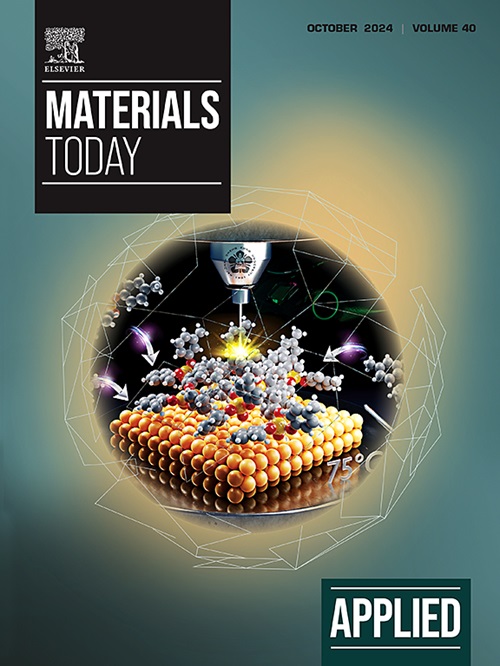用于选择性挥发性有机化合物传感器的离子注入 MXene 电极
IF 6.9
2区 材料科学
Q1 MATERIALS SCIENCE, MULTIDISCIPLINARY
引用次数: 0
摘要
要将这些材料所引起的巨大研究兴趣产业化,就需要有强大的 MXene 功能化手段。尽管已经有许多关于用于蒸汽传感的功能化 MXene 的报道,但大多数报道都集中在非均匀添加剂上,如纳米粒子、聚合物、石墨烯等,结果都非常出色,但这些技术很难持续复制。本研究提出了一种用于 VOC 传感的 MXene 功能化新方法--在丝网印刷的 MXene 薄膜上植入选定的金属离子。这种方法本身具有高度的可重复性和一致性,而且不会在薄膜中产生金属相,从而导致经典掺杂。利用 X 射线衍射、X 射线光电子能谱和扫描电子显微镜解释了植入过程中发生的 TiCT 过程。使用二次离子质谱法对离子分布进行建模和测量,并讨论了该技术的局限性。最后,研究表明,通过将原始电极与镍、铜和钯掺杂的 TiCT 电极阵列组合在一起,可以在操作相关范围内区分 5 种挥发性有机化合物和水。这种方法不仅为传感,还为其他 MXene 应用提供了一个利用植入技术使其他离子功能化的蓝图。本文章由计算机程序翻译,如有差异,请以英文原文为准。
Ion implanted MXene electrodes for selective VOC sensors
Robust means of MXene functionalization are needed to industrialize the huge research interest that these materials see. Although there have been many reports on functionalized MXenes used for vapor sensing, most have focused on non-uniform additives such as nanoparticles, polymers, graphene etc. resulting in outstanding results, however achieved with techniques difficult to reproduce consistently. In this work a new approach to MXene functionalization for VOC sensing is proposed - implantation of screen printed MXene films with selected metal ions. This approach is highly reproducible and uniform on its own, but also yields no metallic phases in the films leading to classical doping. Using X-ray diffraction, X-ray photoelectron spectroscopy and scanning electron microscopy the processes taking place TiCT during implantation are explained. The ion distribution is modeled and measured using secondary ion mass spectrometry, as well as discuss the limitations of the technique. Finally, it is shown that by setting together an array of virgin and Ni, Cu and Pd-doped TiCT electrodes, it is possible to differentiate between 5 VOC and water in the operationally relevant range. This approach shows a blueprint for functionalization with other ions using implantation not only for sensing, but also for other MXene applications.
求助全文
通过发布文献求助,成功后即可免费获取论文全文。
去求助
来源期刊

Applied Materials Today
Materials Science-General Materials Science
CiteScore
14.90
自引率
3.60%
发文量
393
审稿时长
26 days
期刊介绍:
Journal Name: Applied Materials Today
Focus:
Multi-disciplinary, rapid-publication journal
Focused on cutting-edge applications of novel materials
Overview:
New materials discoveries have led to exciting fundamental breakthroughs.
Materials research is now moving towards the translation of these scientific properties and principles.
 求助内容:
求助内容: 应助结果提醒方式:
应助结果提醒方式:


